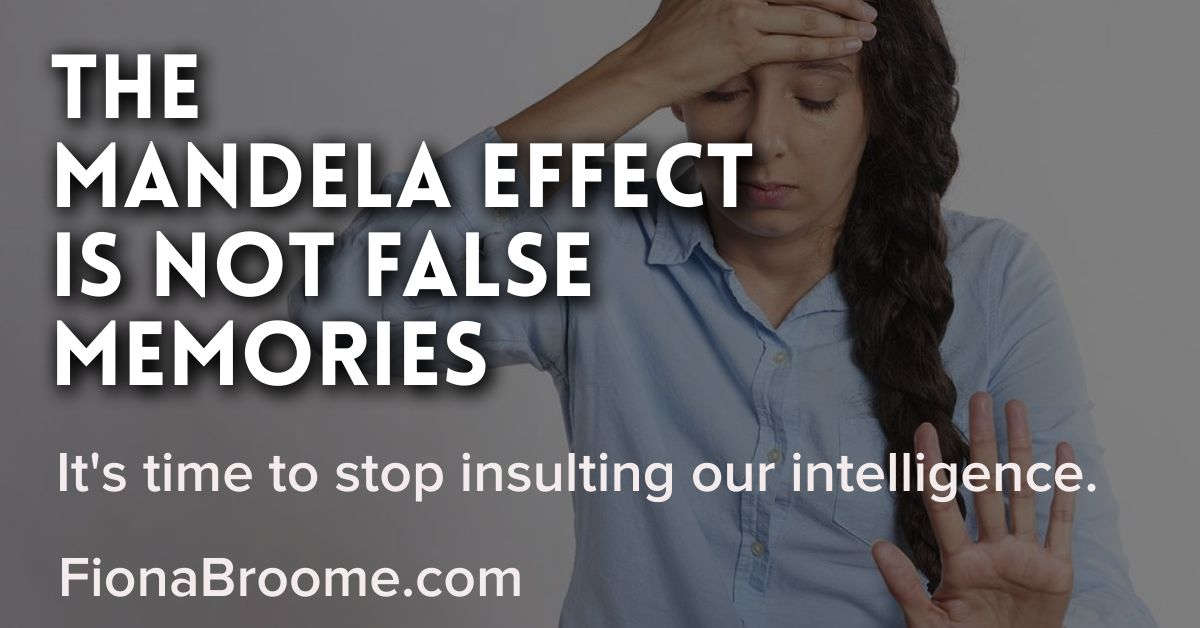Note: As an author and Amazon Associate I earn from qualifying purchases.
___
This should be clear: The term “Mandela Effect” describes the phenomenon, not an explanation of it.
When a reporter or blogger claims the Mandela Effect is a “theory,” they haven’t done their homework.
Likewise, when the Mandela Effect is brushed off as “false memories,” the person is — perhaps conveniently — missing the point.
And they’re insulting our intelligence at the same time.
Yes, some odd memories can be explained as false memories. With a little research, you may be able to find where the mistake happened.
(If it’s a false memory, it’s not the Mandela Effect; it’s a false memory.)
But many people’s first-person stories about the Mandela Effect aren’t so easy to dismiss.
What’s not the Mandela Effect
Everyone has had a moment (or two or three) where they said, “Wait… I really believed [something] was real.”
That “something” could be a small incident, or it might be something big and troubling.
For example, an early, possibly traumatic moment may have been discovering that Santa Claus doesn’t deliver gifts on Christmas Eve after all.
At the other end of the spectrum, there’s the frustration of thinking you left your car keys or the TV/streaming remote in a certain location… but it’s not there when you look.
Those aren’t the kinds of beliefs and memories we’d describe as the Mandela Effect.
Likewise, there are assorted other reasonable explanations for conflicts between what a person remembers and what actually happened.
Ruling out obvious answers
Here are some commonplace explanations for “different” memories of the past:
-
- Faulty news reporting
- Jokes that were taken seriously
- Hyperbole by those who like to stir up drama
- What some scientists term the “broken telephone effect” refers to a party game (sometimes just called “telephone”).
Those are part of everyday life. When we find a reasonable explanation among them, we’re unlikely to think about our mistaken memories again.
In other words, if there’s a clear, sensible answer to our past confusion or misunderstanding, it’s not the Mandela Effect.
Most of us recognize that.
We do our homework. We fact-check our recall and our memories.
That’s common sense.
If all the answers were simple, I wouldn’t have started the Mandela Effect website.
Once the novelty of a personal, baffling memory wears off, many of us keep looking for answers. That was—and still is—the reason for the Mandela Effect website.
At first, I hoped others might offer a simple explanation for my memories of Nelson Mandela’s funeral. (So far, no easy answer has been a match to what I recall.)
Then, when more memories—different from recorded history—emerged, the Mandela Effect became really interesting.
And fun.
Meanwhile…
I’m unsure whether I should feel sorry for those who choose the simple “false memories” explanation.
They’re missing the intrigue of exploring a wealth of evidence, such as credible 19th-century doppelgänger reports, that may point to parallel realities and Many Interacting Worlds.
For me, that’s the fun part of Mandela Effect speculation and research.
Yes, for those who rush to simplistic answers, perhaps life may be complex and challenging enough.
That’s okay. They have my sympathy, and—really—I have nothing to prove.
However, I’m irked when small, vocal groups of critics (and reporters rushing to meet a deadline) suggest that we’re not bright enough to fact-check our own memories. Or throw other badly flawed accusations at us.
My message to them is this: Attempting to brush aside the Mandela Effect as “false memories” will not make science vanish.
(After all, 19th and 20th-century efforts to ignore quantum physics merely delayed its inevitable emergence as a serious study affecting everyday life and perceptions.)
I applaud those who continue to seek answers to the curious aspects of the Mandela Effect.
And I’d really like the insulting rhetoric to cease.
[This rant was expanded from part of a longer article that appeared on my Mandela Effect website.]

